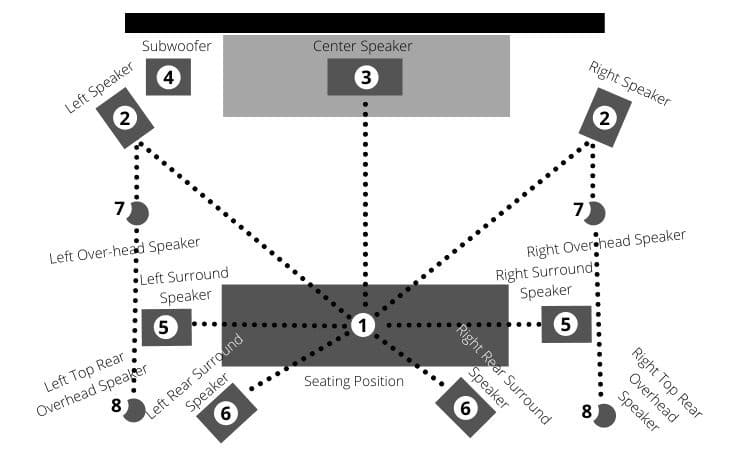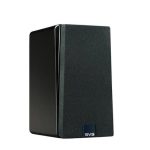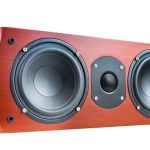A good home theater system is crucial to enjoying your movies and music, but it does not stop there. Over the years, there have been notable advancements in sound systems to ensure that you get to experience your favorite movies in their full glory and not just half the experience.
Thanks to Dolby Atmos, we are no longer limited to basic 5.1 or 7.1 surround sound setups. Dolby Atmos lets you enjoy a fully engulfing cinema-like experience in your room by adding extra height channels. The idea behind Dolby Atmos is that instead of hearing a jet flying at your ears’ height, you’ll be able to experience the jet move like it’s right above you.
Dolby Atmos setups use a little different speaker configuration from longstanding surround sound setups to cater for the extra height channels. Most people prefer to go with a simpler 5.1.2 or 5.1.4 configuration, but there are more advanced setups if you want to go a notch higher.
We have previously discussed the 5.1.2 Dolby Atmos speaker placement. Today we are going to decode the 7.1.4 speaker placement. For the purpose of this guide, we’ll help teach how to plan a 7.1.4 speaker layout for an amazing Dolby Atmos sound experience.
7.1.4 Dolby Atmos Speaker Placement

For this setup, you’ll need;
- Seven main speakers(three front channels, two side surround channels, and two rear surround channels)
- One subwoofer
- Four overhead/ Dolby Atmos Speakers
You’ll also need to get a Dolby Atmos-enabled home theater receiver with at least 11 powered channels. The good thing is that there are plenty of such receivers that will deliver the ultimate Dolby Atmos entertainment experience.
For this configuration, you’ll only need one subwoofer, but you can always add a second one later if so desired. When it comes to subwoofer placement, we recommend you try and find the most ideal location acoustically that will make the subwoofer work optimally and look good in the room. You can learn more on subwoofer placement tips here.
7.1.4 Ideal Speaker Placement
Main left/right channels
The front left and right speakers can be compared to a conventional stereo pair in a hi-fi system. Ideally, you’ll want to balance the front channel sound field by ensuring that all three front channels complement each other.
When positioning the left and right speakers, ensure that they are at an equal distance from both the TV and your primary listening area. You’ll also need to angle the speakers in towards the listening area. However, the positioning angle will vary depending on the shape and size of your specific room.
Center channel
Like any other surround sound setup, the center channel speaker should go below or above the TV, but this may vary depending on the size of your screen. Ideally, the center channel should point you directly, assuming that the seating position is centered to the middle of the screen. Just ensure that you don’t place the center channel too far from your TV to avoid disconnecting the sound from the picture.
Side surround channels
The ideal position for the left and right surround speaker in a 7.1.4 setup is on either side of the listening position- preferably at 90°. Positioning the speakers at ear level will also deliver an incredible surround sound effect.
Rear surround channels
As we stated earlier, this setup comes with two extra rear surround speakers. Ideally, these channels should go behind the sitting position directly facing towards you. And just like side surround channels, the rear speakers should be raised at ear level/near head height. You’ll also need to spread the speakers at the same angle as the front speakers if possible.
Overhead/Atmos channels
This setup utilizes four overhead/ Dolby Atmos-enabled speakers to reproduce the overhead sound effects. If you’re using the overhead speakers, you’ll need to install them up high as in-ceiling or on-ceiling speakers. When installing these speakers you’ll want to ensure that they are centered around the listening area and at the same time aligned with the main front and rear surround speakers.
The other option is getting four Dolby Atmos-enabled speakers. With this setup, you can opt to place the speakers on or near the existing front and rear speakers to recreate the overhead sounds. Alternatively, you can decide to go with traditional speakers that incorporate Dolby Atmos in one unit. These speakers are designed to reflect the overhead sounds off the ceiling back to the listener.
Parting Shot!
Setting up a Dolby Atmos sound system can be a tasking project, but as long as you follow the above guidelines, you should be in a better position to build an effective 7.1.4 speaker setup. The most important thing is to experiment with different positions and let your ears decide for you what sounds best or the most ideal location. For best results, ensure that your AV receiver accommodates this setup and that you have enough space in your living room.
Michael Evanchuk is a San Francisco-based sound engineer with 20 years’ experience installing, troubleshooting, and repairing commercial, automotive, and household sound equipment. Evanchuk owns an auto stereo center, where he offers highly competitive car audio installation and repair services. He has written dozens of articles on different sound engineering topics, all of which have been published in leading journals, blogs, and websites.





